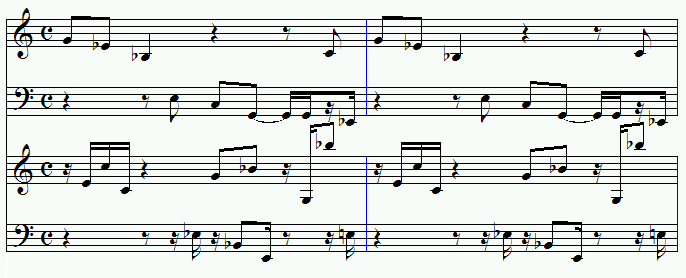MathWorld Headline News
WolframTones Launched by Wolfram Research
September 12, 2005--Tip a swath of a mathematical pattern onto one side and interpret it as a musical score, say by letting the height of each black square determine the pitch of a corresponding note in some musical scale. For example, consider applying this process to a simple program such as an elementary cellular automaton, illustrated below. What happens?
 |
 |
You can find the answer, together with much more related information, at the new WolframTones site, where you can read more about how it works or go to the top page and start using the site directly.
WolframTones uses various Mathematica algorithms to create music from cellular automaton patterns. In its simplest form, this works by taking every block of contiguous black cells at a certain height and mapping it to a single note played by the same instrument. The result for elementary cellular automaton Rule 30, starting from a single black cell, is shown below transcribed in the Scriabin musical scale and using a grand piano.
 |
Click on the image at left to listen to the WolframTones version of this cellular automaton. |

The initial launch of WolframTones allows exploration of 16 different cellular automaton systems, with billions of possible rules for all but the simplest rules systems. WolframTones supports more than 300 musical scales, in excess of a hundred instruments, and thousand of different style combinations. Although everything starts from a single underlying cellular automaton pattern, different instruments can be set up to pick off different aspects of the pattern--say to correspond to a melodic line or a bass track. WolframTones also supports a number of algorithms for deriving percussion from cellular automaton patterns.
The composition above uses radius-1 cellular automaton Rule 30. Here is a radius-2 rule, in this case rule 4444444:
 |
Click on the image at left to listen to the WolframTones version of this cellular automaton. |
Note that the melody above starts with simple rule number and produces interesting behavior when given a single cell initial condition. (As it turns out, rule 1000000 is quite dull starting from a single cell.) Many rules generate only very simple behavior that isn't appropriate as a basis for any ordinary music. However, searching through a few dozen readily led to the "interesting" rule 4444444. That's of course the hard way to do it; generating an interesting tone at random is as simple as clicking a single button -- Mathematica then evaluates dozens of rules, then selects the rules exhibiting the best class 3 or class 4 behavior, as described in Stephen Wolfram's book A New Kind of Science. So upon visiting the site, you can just click the "Start Now" button and you should get an interesting piece of algorithmically-generated music that has never been heard before.
 |
Click on the image at left to listen to the WolframTones version of this cellular automaton. |
If it's not interesting enough, click on the "Random Style" button again. Alternately, choose one of the fifteen music styles, and something from that genre will get generated. If what you've found is close to something you like, you can modify the instruments, the musical scale, the initial conditions, the rule, or the tempo. With enough time, you could give a distinct WolframTones composition to every atom in the universe.
More usefully, you can download the music as a ringtone to just about any cellular phone and use it as your ringtone. You can also save anything you've generated in your own MyTones page (here's a link to a MyTones page for this article), and share it with your friends. If that's still not enough, check back again soon, since many possibilities are being considered for the future.
In summary, try out WolframTones, and see what the computational universe can do for your musical proclivities.
ReferencesWolfram Research. "About WolframTones." http://tones.wolfram.com/about/
Wolfram Research. "How WolframTones Works." http://tones.wolfram.com/about/how.html
Wolfram Research. "WolframTones: An Experiment in a New Kind of Music." http://tones.wolfram.com/
Wolfram, S. A New Kind of Science. Champaign, IL: Wolfram Media, 2002.